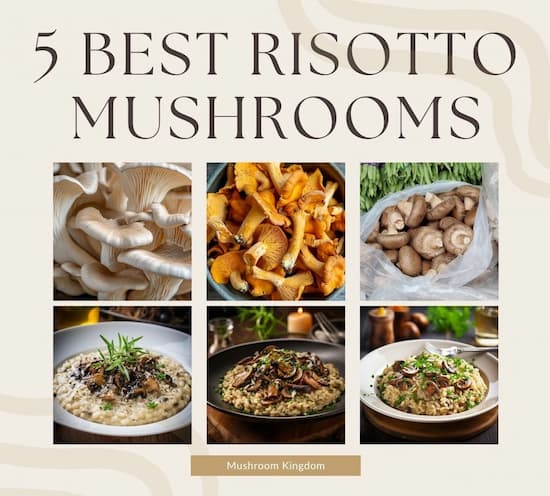Not many people know how to store mushrooms properly. Incorrect storage can lead to mushy, slimy mushrooms that spoil quickly.
This guide will teach you how to store mushrooms the best way, ensuring they stay fresh and flavorful.
How To Store Mushrooms
The key to storing mushrooms successfully starts with selecting fresh mushrooms. Look for mushrooms that are firm and dry to the touch, free from dark spots or slimy patches, with closed caps (gills not visible) for button and cremini mushrooms, and have a fresh, earthy smell.
Fresh mushrooms are less likely to spoil quickly and will retain their texture and flavor longer.
How to Store Fresh Mushrooms In Fridge?
To store fresh mushrooms in the refrigerator, place them in a paper bag and fold the top over. The paper will absorb any excess moisture and allow the mushrooms to breathe.
Store the paper bag in the main compartment of the refrigerator, as the crisper drawer can be too humid. Inspect the mushrooms every few days for signs of spoilage, such as dark spots or a slimy texture. Remove any spoiled mushrooms to prevent them from affecting the rest.
Another effective method is to wrap the mushrooms in paper towels and place them in an open plastic container or a loosely closed paper bag. If the paper towels become damp, replace them to keep the mushrooms dry.
How To Store Cooked Mushrooms?
First, allow the cooked mushrooms to cool to room temperature. Hot mushrooms placed directly in the refrigerator can cause condensation, which leads to excess moisture and potential spoilage.
Spread the mushrooms out on a baking sheet or a large plate to speed up the cooling process. This step is essential to avoid trapping heat, which can create a breeding ground for bacteria.
Choose the Right Container
Next, select an airtight container for storing your mushrooms. Glass or plastic containers with tight-fitting lids work well. The airtight seal helps to keep the mushrooms fresh by preventing exposure to air, which can dry them out or cause them to spoil faster.
Avoid using containers that don’t seal properly, as they can lead to moisture buildup and a shorter shelf life.
Store in the Refrigerator
Place the cooled mushrooms in the chosen container and seal it tightly. Store the container in the main compartment of your refrigerator. Cooked mushrooms should be kept at a consistent temperature to prevent spoilage. They typically stay fresh for up to five days when stored correctly.
Label and Date
For better organization and to avoid confusion, label the container with the date you cooked the mushrooms. This practice helps you keep track of how long they have been stored and ensures you use them within their optimal freshness period. Using a piece of masking tape and a permanent marker works well for labeling.
How to Freeze Cooked Mushrooms?
If you want to store cooked mushrooms for an extended period, consider freezing them. First, spread the cooked mushrooms on a baking sheet in a single layer and place them in the freezer.
Once they are frozen solid, transfer them to a freezer-safe bag or container. Label the bag with the date and type of mushrooms. Frozen cooked mushrooms can last for up to six months.
When you need them, thaw the mushrooms in the refrigerator overnight and reheat them thoroughly before use.
Reheating Cooked Mushrooms
When you’re ready to use the stored mushrooms, reheat them thoroughly. You can use a microwave, stovetop, or oven, depending on your preference and the dish you’re preparing. Make sure they reach an internal temperature of at least 165°F (74°C) to ensure they are safe to eat. Reheating brings back their rich flavor and helps maintain their texture.
General Storage Tips
First, avoid plastic bags. Mushrooms are mostly water, and storing them in plastic bags can trap moisture, leading to sliminess and mold growth. nstead, opt for paper bags, which allow the mushrooms to breathe. Also:
- Do Not Wash Before Storing: Washing mushrooms before storing can introduce excess moisture. Instead, clean them just before use.
- Keep Them Cool: Mushrooms should be stored in the refrigerator, ideally at a temperature between 32°F and 36°F (0°C to 2°C).
How To Freeze Fresh Mushrooms
- Clean Thoroughly: Wipe the mushrooms with a damp cloth to remove dirt.
- Slice or Leave Whole: Depending on your preference, you can either slice the mushrooms or leave them whole.
- Blanching: Blanching helps preserve the mushrooms’ texture and flavor. Bring a pot of water to a boil, add the mushrooms, and boil for 2–3 minutes. Immediately transfer the mushrooms to an ice bath to stop the cooking process.
- Dry Completely: Pat the mushrooms dry with a paper towel.
- Flash Freeze: Spread the mushrooms in a single layer on a baking sheet and freeze until solid. This step prevents them from sticking together.
- Store in Freezer Bags: Transfer the frozen mushrooms to freezer bags, removing as much air as possible. Label the bags with the date and type of mushrooms.
Freezing Cooked Mushrooms
- Cook as Desired: You can sauté, steam, or cook the mushrooms however you prefer.
- Cool Completely: Allow the cooked mushrooms to cool to room temperature.
- Store in Airtight Containers: Place the mushrooms in airtight containers or freezer bags.
- Label and Freeze: Label the containers with the date and freeze. Cooked mushrooms can be stored for up to six months.
How To Dry Mushrooms
Drying is another effective method for long-term storage, particularly for mushrooms like shiitake or porcini.
Using a Dehydrator
- Clean and Slice: Clean the mushrooms and slice them into even pieces.
- Arrange on Trays: Place the slices on the dehydrator trays, ensuring they are not touching.
- Dehydrate: Set the dehydrator to 135°F (57°C) and dry the mushrooms for 4–8 hours, or until they are completely dry and brittle.
- Store in Airtight Containers: Once dried, store the mushrooms in airtight containers in a cool, dark place.
Using an Oven
- Preheat Oven: Preheat your oven to its lowest setting, usually around 150°F (65°C).
- Prepare Mushrooms: Clean and slice the mushrooms, then place them on a baking sheet lined with parchment paper.
- Dry in Oven: Place the baking sheet in the oven and leave the door slightly open to allow moisture to escape. Dry for several hours, checking regularly until the mushrooms are dry and brittle.
How to store dried mushrooms?
Store dried mushrooms in airtight containers kept in a cool, dark place to maintain their flavor and texture. For extended storage, consider vacuum-sealing them to protect against moisture and pests.
To use dried mushrooms, rehydrate them by soaking in warm water for 20–30 minutes. Once rehydrated, they can be used in recipes just like fresh mushrooms. The soaking liquid, rich in mushroom flavor, can also be used as a broth.
Understanding Mushroom Types
Before diving into storage methods, it’s essential to understand that different types of mushrooms might require slightly different approaches. Common varieties include:
- Button Mushrooms: These are the most commonly found mushrooms in grocery stores. They have a mild flavor and a firm texture.
- Cremini Mushrooms: Also known as baby bellas, these have a richer flavor than button mushrooms.
- Portobello Mushrooms: These are mature creminis with a meaty texture, often used as a meat substitute.
- Shiitake Mushrooms: Known for their strong, earthy flavor, these mushrooms are popular in Asian cuisine.
- Oyster Mushrooms: These have a delicate flavor and are often used in stir-fries and soups.
Final Thoughts on How To Store Mushrooms
Storing mushrooms properly ensures you get the most out of their flavor and nutritional benefits.
Whether you’re refrigerating, freezing, or drying them, these methods will help keep your mushrooms fresh and delicious. By following these guidelines, you can enjoy mushrooms in your dishes anytime, without worrying about spoilage.


